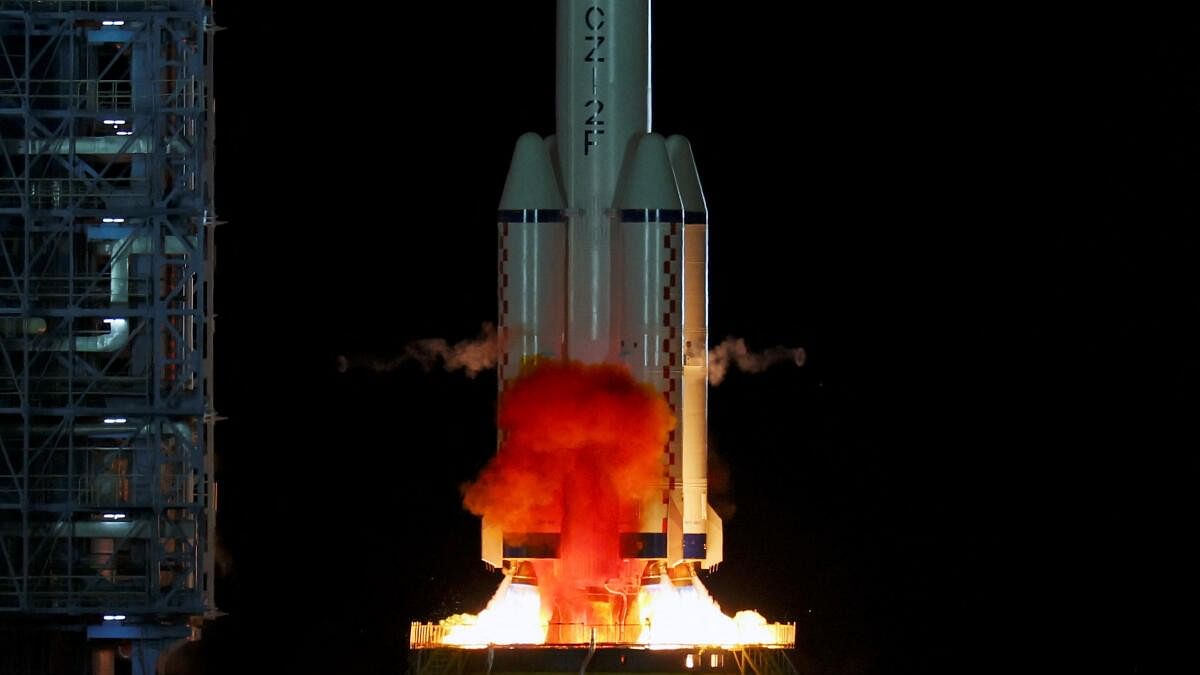
Long March-2F rocket carrying the Shenzhou-19 spacecraft takes off from Jiuquan Satellite Launch Center
Credit: Reuters Photo
Jiuquan, China: China sent three astronauts on Wednesday to its permanently inhabited space station, where they will conduct dozens of scientific experiments, some related to the construction of human habitats.
The spacecraft Shenzhou-19 and its three crew lifted off atop a Long March-2F rocket from the Jiuquan Satellite Launch Centre in northwest China at 4:27 a.m. (2027 GMT), according to state media.
"During the Shenzhou-19 flight ... 86 space sci-tech experiments will be carried out in the fields of space life sciences, microgravity physics, materials, medicine, new technologies," Lin Xiqiang, deputy director of the China Manned Space Agency (CMSA), said in a press conference on Tuesday.
One of these experiments is expected to involve exposing bricks made from simulated lunar soil to conditions in space.
Should the tests prove successful, the bricks could be a key material used in the construction of a permanent lunar research station, which China hopes to complete by 2035, as it would in theory be more convenient than transporting building materials from Earth.
The bricks will be sent in a separate uncrewed cargo spaceflight to the Shenzhou-19 crew next month.
The Shenzhou crewed spaceflights have been a regular fixture of China's space program for the past two decades and have increased in frequency in recent years as China built and began operating its "Tiangong" space station, officially completed in November 2022.
The fast development of China's manned and unmanned space program has alarmed the United States, which has encountered issues with its own crewed spaceflights.
Two NASA astronauts brought to the International Space Station by Boeing's Starliner capsule in June have been stranded there since due to unforeseen issues with the spacecraft's propulsion system. They are expected to return in February 2025 on a SpaceX Crew Dragon spacecraft.
CMSA's Lin on Tuesday said that in order to avoid similar issues, the emergency response plan has been "continuously optimized" so that astronauts have more time to deal with scenarios such as damage to the Shenzhou-19 caused by space debris.
Lin added that Shenzhou-20 and its carrier rocket were on standby and ready to perform an emergency rescue mission if necessary.
Looking on the Moon
Since the launch of Shenzhou-14 in June 2022, Shenzhou missions have involved trios of astronauts and six-month stays in space, with an overlap period of several days where the departing crew hands over the station to the newly arrived group. The Shenzhou-19 crew is expected to return to Earth next year in April or May.
Lin highlighted that two of the three astronauts crewing the Shenzhou-19 were born in 1990 and conducting their first spaceflight, with Wang Haoze also being the third female Chinese national sent into space.
The leader of the crew, 48-year-old Cai Yuzhe, was part of the Shenzhou-14 crew that completed Tiangong's construction. Outside the mission, all three crew members are part of the Chinese military's air force.
As Tiangong approaches its second anniversary, China's focus has now turned to the goal of achieving a manned landing on the moon by 2030. In May, China's Chang'e-6 lunar probe was launched from the island province of Hainan and successfully returned a month later.
While the mission was uncrewed, its completion made China the first country to retrieve samples from the moon's far side.
The two younger Shenzhou-19 crew members were part of the third batch of astronauts selected to train for future spaceflights. The fourth batch, announced in 2022, will for the first time be more focused on moon landings, rather than just flights to the Tiangong space station, according to Lin.
"(The training content of the fourth batch) will extend the astronauts' abilities, from controlling spacecraft to driving lunar rovers, from celestial body identification to geological exploration, from weightless floating in space to carrying heavy loads on the moon," the CMSA official said.